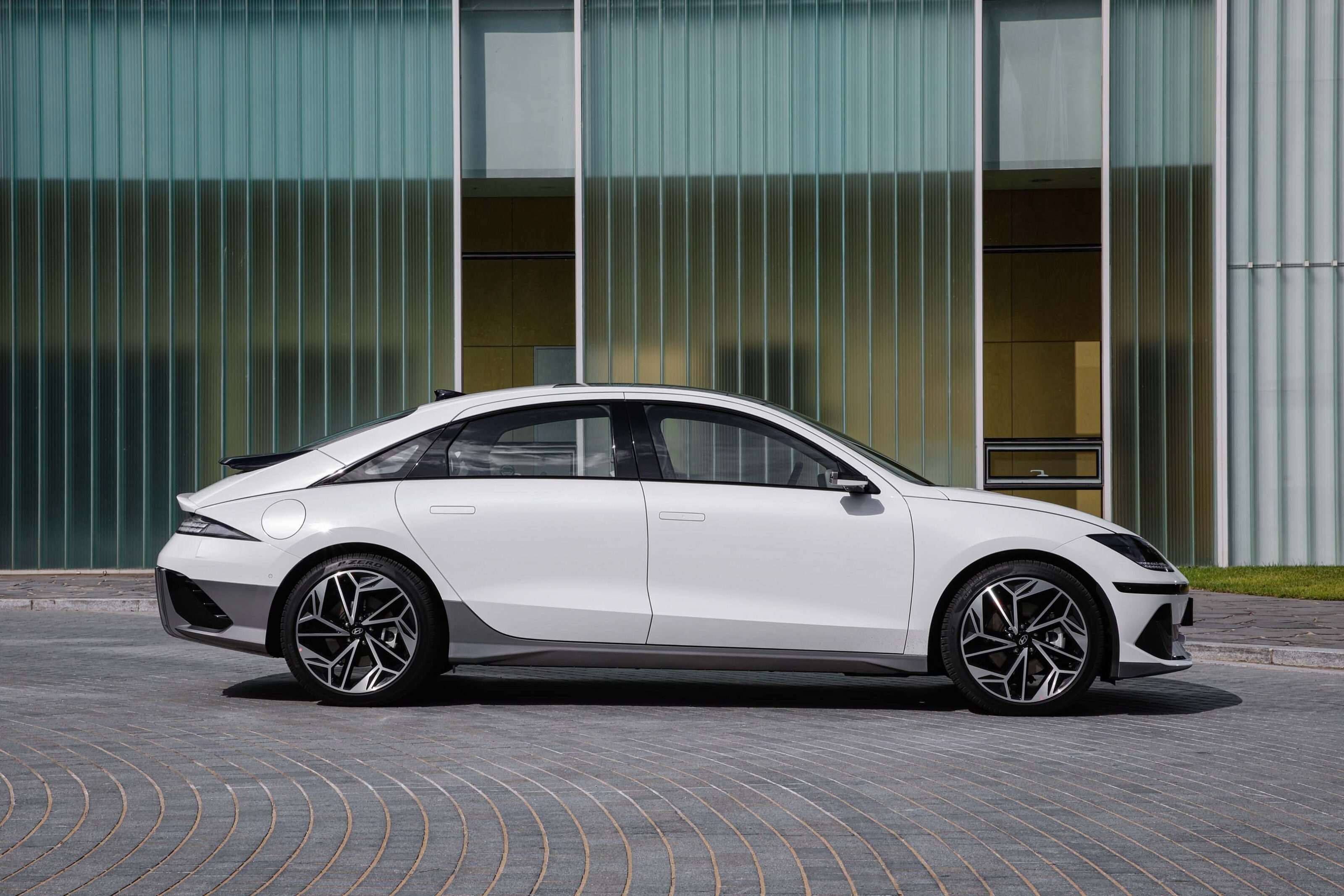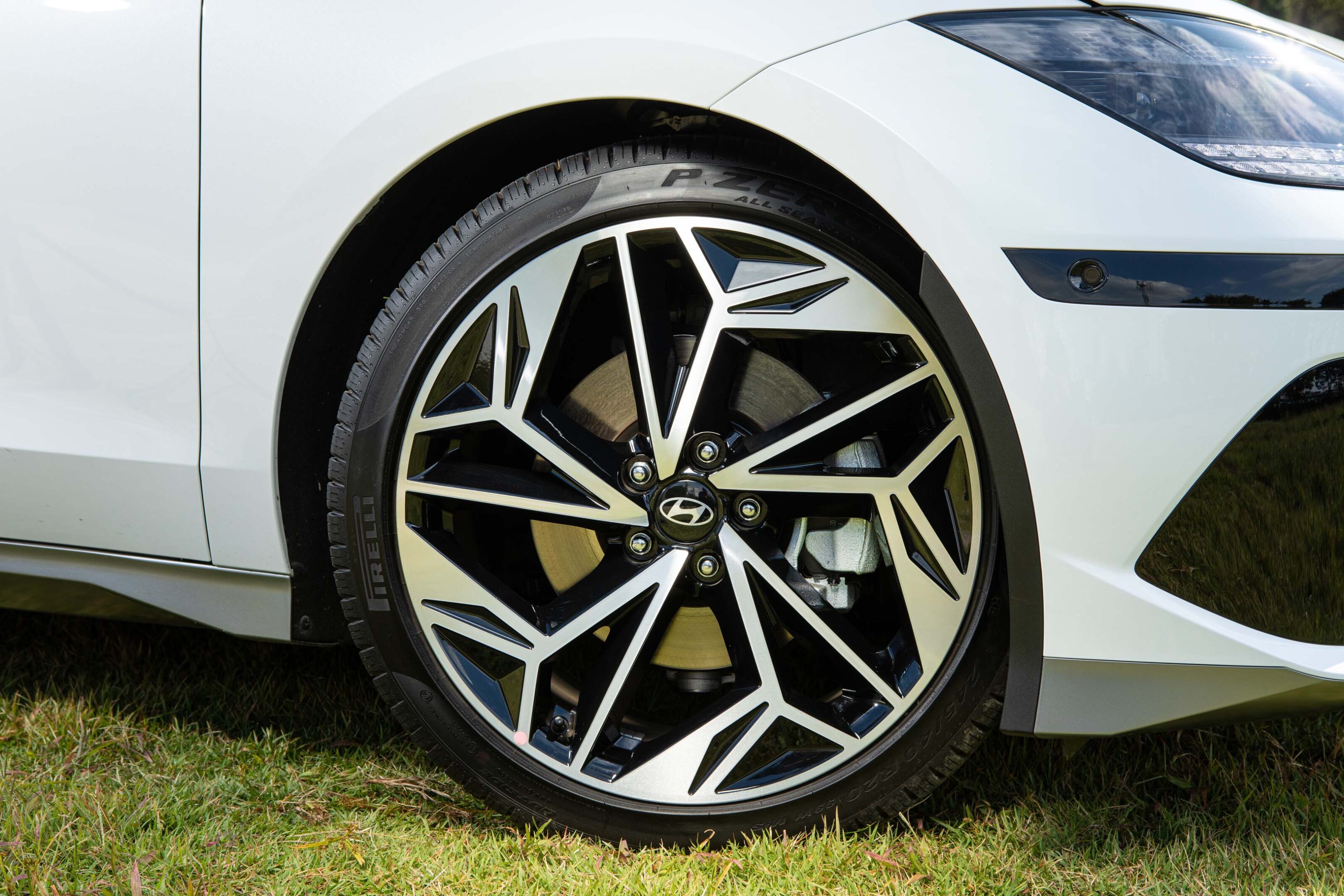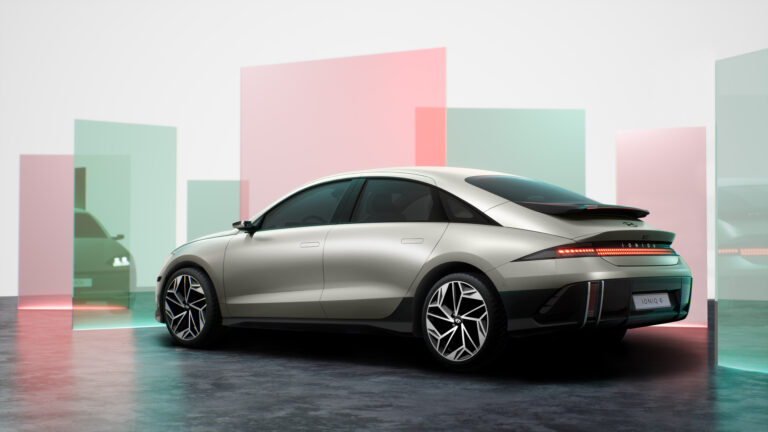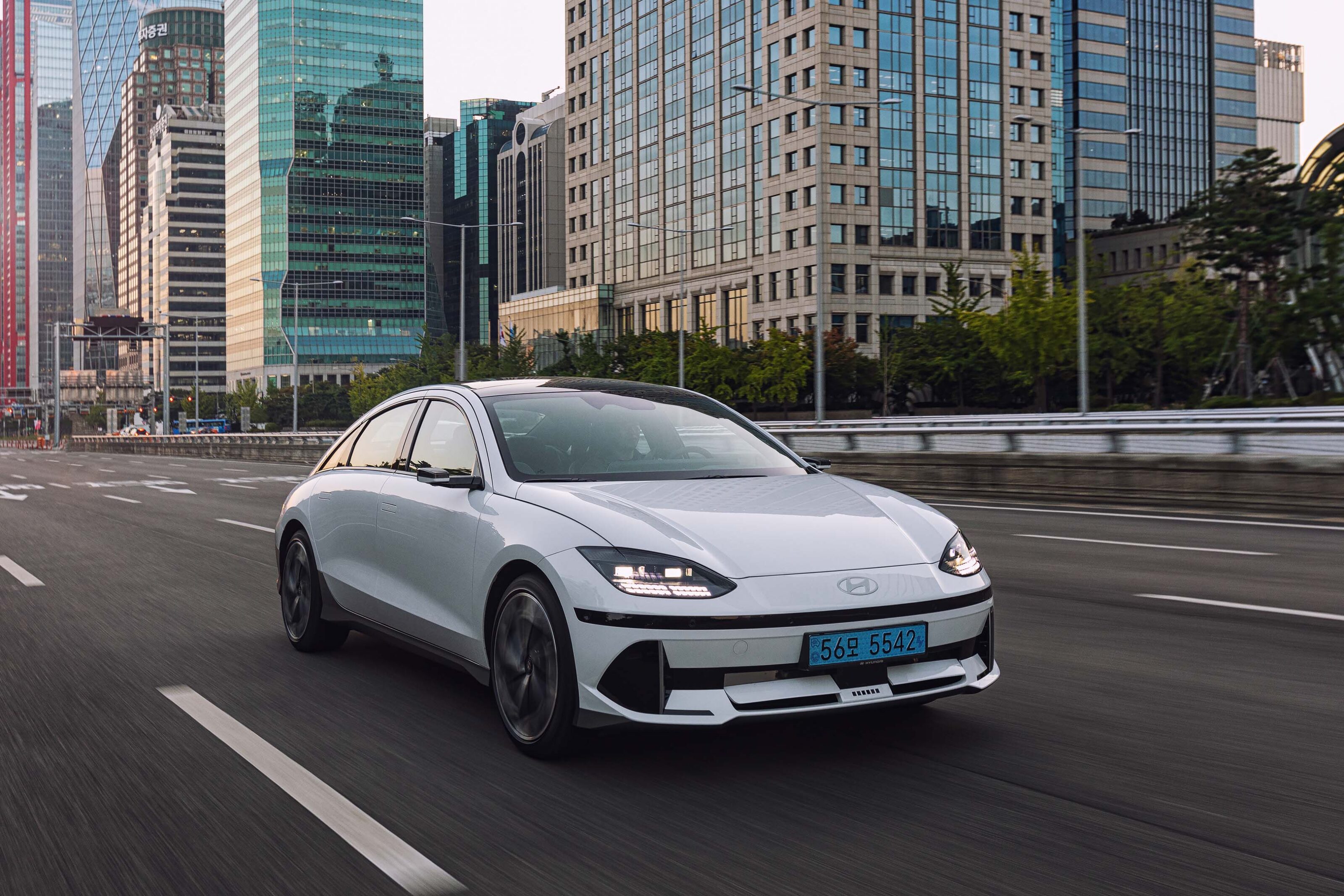Score breakdown
Things we like
- Addictive electric performance
- Spacious, light-filled cabin
- Rock-solid build quality
Not so much
- Slightly sporty ride
- Weight blunts handling
- Availability
Hyundai’s chief stylist Simon Loasby has just three seconds to sell a new vehicle concept to one of the busiest, richest and most powerful men in Korea.
Just once a month, Hyundai Motor Group Executive Chair Euisun Chung visits Loasby’s Seoul design studio. If Loasby manages to halt Chung’s progress in the metaphorical hallway, he uses another 30 crucial seconds to sell the concept further. After that, Chung is hooked – hopefully.
In charge of dozens of separate companies within the Hyundai empire, Chairman Chung might be busy, but he loves risky automotive styling. He’s directly credited with empowering the Korean carmaker’s design team to push the visual limits.

That includes the 1980s-inspired, boxy IONIQ 5 electric vehicle; the Staria commercial van which makes tradies look like they’re driving something out of Tron; and even the basic Tucson with lines so sharp you could almost cut your finger.
It’s Chung’s appetite for gambling on design that has transformed Korea’s roads and made German design studios look old, stuffy and snoozy. Full of daringly-designed cars, at pedestrian level Seoul feels like a progressive, high-tech place. And that has a lot to do with the cars.
Unlike Australia, sedans are still the most popular type of vehicle in South Korea – so it was only a matter of time before we saw an all-electric sedan.
Enter the IONIQ 6 we’re driving today.

According to Loasby’s three-second pitch, it’s “the most aerodynamic car we’ve ever done”.
Loasby says that at the start of the IONIQ 6 program in April 2019, when it was still but a blank piece of paper, he cheekily wore into Hyundai’s offices a custom-printed t-shirt emblazoned with “0.1X” – alluding to an ambition to get the IONIQ 6 under a 0.2 Cd drag coefficient.
Created around the same purpose-built “E-GMP” 800-volt dedicated electric architecture that underpins IONIQ 5 and the Wheels Car of the Year-winning Kia EV6, the IONIQ 6 has been sculpted by the wind tunnel.
Its 0.21 Cd drag coefficient didn’t quite meet Loasby’s lofty dream, but it’s still one of the lowest of any production vehicle. Mercedes’ own EQS – its first-ever dedicated electric vehicle – is the most aerodynamic series-production car in history, at 0.2 Cd.
2023 Hyundai IONIQ 6: The basics
| Motors | Dual (front+rear) |
|---|---|
| Battery | 77.4kWh |
| Max power | 239kW |
| Max torque | 605Nm |
| Range | 614km (WLTP claimed, 18-inch wheels, 2WD) |
| Price | $80,000 (estimate) |
| On sale | Q1 2023 |

Hyundai’s aerodynamicists would have kept tapering to a point if allowed, but a two-metre rear overhang was deemed, well, impractical.
A Tesla Model 3 is 0.23, while the most aerodynamic (and low-volume) production car, the 2013 VW XL1, was 0.189. A new VW Golf is something like 0.275. Be in no doubt, the IONIQ 6’s 0.21 Cd is an impressive achievement.
Aerodynamics is key in the world of electric cars (as some owners have found when fixing surfboards to the roof racks of their new EVs and then attempting to go on extended road trips). In the case of the IONIQ 6 – which Hyundai calls an “electrified streamliner”; you’ll be frowned at for calling it a four-door sedan – it starts with its sloping roofline, converging at the rear for something of the classic teardrop shape.
Hyundai’s aerodynamicists would have kept tapering to a point if allowed, but a two-metre rear overhang was deemed, well, impractical. So were rear wheel spats and flat aero wheels like the XL1 – they trapped dirt, added cost and just didn’t make overall sense.

Best Electric Cars Under $65k: Affordable EVs Rated
Welcome to part one of three price-based EV buying guides, this one focused on the most affordable electric cars available in Australia today

Poking your head around the IONIQ 6’s exterior, you’ll find all the classic aerodynamic tricks – flush door handles, a completely flat under-floor, active aero flaps on the lower front bumper which open as the liquid-cooled battery pack demands, even video side mirrors whose antennae-like protrusions reduce drag and add 1.5km of range.
One other innovation is the “wheel gap reducer”, a bit of vertical plastic trim ahead of the front wheel which does what it says on the tin. This effectively extends the front overhang (a long front overhang is good for aero, apparently) and helps the airflow stick to the side of the car.
Hyundai says this was just some random idea a designer had, that they tried, which turned out to work surprisingly well. Expect to see it on other models in future.

The attention to aero adds 107 kilometres of extra range, if you compare the IONIQ 6 with the boxy 0.288 Cd IONIQ 5, using the same 239kW dual-motor powertrain and 77.4kWh battery (614km claimed WLTP range versus 507km). This figures comes with a few catches which exclude using an IONIQ 6 to power your dishwasher. We’ll come back to them.
Loasby informs Wheels there was no friction – pardon the pun – between Hyundai’s styling team and aerodynamicists. “They were great”. That means, we are left to assume, that the final styling is what he wanted. As ever, we’ll leave judgement to you.
In the end, the slug-shaped IONIQ 6 looks as if the team filled a simmering cauldron with different car designs and ladled-out whatever bubbled up. The rear looks like something a 992 911 would regret after a saucy night with an AU Falcon. It’s certainly different – not that it turned many heads in Seoul. Even Hyundai’s hottest new electric car can’t get a South Korean fizzy like a Ferrari does a red-blooded Italian.

In the end, the slug-shaped IONIQ 6 looks as if the team filled a simmering cauldron with different car designs and ladled-out whatever bubbled up.
The IONIQ 6’s oily bits – not that there are that many – are a 168kW/350Nm motor out back, and a 71kW/255Nm motor up front offering all-wheel drive. The high-tech lithium-ion battery pack supports up to 350kW DC fast-charging (although it’ll generally peak at around 230kW as a battery preservation function), which can top the battery up from 10 to 80 percent in just 18 minutes.
In Australia, on a typical single-phase 7kW AC at-home charging wall-box, the IONIQ 6 will go from flat to full in about 12 hours; utilising its maximum 11kW three-phase AC charging capability reduces that to more like eight hours.
Like the IONIQ 5, the IONIQ 6 supports “vehicle-to-load” inside and out, meaning it can power 240V appliances like a kettle, hair-dryer, laptop, and so on. (No, you can’t plug it into itself, although you can recharge other EVs in a pinch.)
Range-wise, only the 2WD model with 18-inch wheels gets the full 614km. We tested an AWD model with 20-inch wheels whose computer was reporting 352km range at 83 per cent capacity (but also we motoring journos have hooves instead of feet).

The dual-motor IONIQ 6 weighs about 2100kg, claims a 0-100km/h time of 5.1 seconds and will cost about $80,000 when it arrives in Australia early next year. A cheaper rear-drive single motor variant will also be offered.
In the metal, the IONIQ 6 is surprisingly long. Indeed, its 2950mm wheelbase – 50mm shorter than IONIQ 5 – is still basically as long as a new Range Rover, lending it huge rear legroom and generous overall cabin capacity (even if rear headroom is tight). Elbow room for front occupants, odd as it is to single that out, is lovely, like sitting in a low-backed armchair.
With sun streaming in through the enormous moonroof, in white trim the IONIQ 6’s interior feels huge and light-filled. There are delightful details everywhere, inside and out.

Ahead of you is the futuristic twin-spoke steering wheel with four illuminated trademark IONIQ pixels, the large dual 12-inch displays for instruments and infotainment, further flanked by additional small live video displays for the side mirrors. The material choices are lovely and the build quality feels rock-solid.
The driving position is good, but you sit slightly high and ‘on’ the car rather than ‘in’ it. Any option to make the seat go lower would have been nice, as would some extra steering reach adjustment. From the driver’s seat, the bonnet plunges away out of view, and the top of the windscreen is surprisingly low – like the roof’s been chopped.
With no sense of an engine starting, the IONIQ 6’s creators have – like all other electric cars – charmed it with all sorts of different chimes and bongs to audibly communicate what it’s ready to do next.

Twist the steering column drive mode selector into D and with a prod of the throttle the IONIQ 6 moves away silently, like a giant golf buggy.
Up to about 25km/h it uses an external speaker to produce a slightly eerie noise to warn pedestrians. Funnily, it’s distinctive enough that if you can only hear it coming, you know it’s a Hyundai IONIQ 6.
There’s also an odd, synthetic interior noise which matches its pitch to your speed, and has three levels of volume. It’s hard to describe what it sounds like; imagine a choir of robots singing a low hymn, changing in pitch excitedly as you accelerate and decelerate, like a cheer squad.
From 70km/h, it’s like a second choir of different robots chimes in. It’s interesting but, gladly, it’s also easy to deactivate. After the novelty (quickly) wore off we preferred to give the fake robot choir an early mark and just enjoy one of the major perks of electric motoring – quietude.

Now, those camera side mirrors.
Initially stressful, they make you wish there was a button to have normal side mirrors fold out, especially if you are first thrust into busy Seoul traffic like we were. But you get used to them – and learn to trust them, and even prefer them to normal mirrors. Red and yellow depth perception lines pop up on the displays as you hit the indicator, making lane-changes a doddle.
Lane-changes on the driver’s side take just a glance without having to move your head, which is a pleasant conserving of precious kilojoules. Overall, they’re interesting and novel – and, importantly, functional – even if the protruding camera stalks themselves seem a bit of a missed opportunity.
Quite chunky, they obscure a surprising amount of forward vision. We didn’t get a chance to ask why the cameras couldn’t just have been mounted on the A-pillars. Just as question-raising was why there are video side mirrors… but then a conventional rear-vision mirror.

While the IONIQ 6 is nice and easy to drive around town – quiet, smooth, punchy, responsive, fast – we noticed our first minor grievance: the ride quality on our 20-inch-wheel-shod test car. The suspension feels tuned for sporty driving rather than pillow-soft comfort.
It’s very comfortable, but not in a wafting kind-of-way. Hyundai’s aerodynamicist told us air suspension and a lower ride height would further reduce the 0.21 Cd drag coefficient. If it was available, improved the ride quality and extended the range, it would have been a worthwhile option – even at $10,000, we reckon.
Like the IONIQ 5, the IONIQ 6 offers six levels of regenerative braking immediately adjustable via steering wheel pedals – including the much-fawned-over “one-pedal” mode sought after by many new electric vehicle owners.

If air suspension were available, improved the ride quality and extended the range, it would have been a worthwhile option – even at $10,000, we reckon.
This winds the electric motor recuperation up so high, you don’t really need to use the brakes. Just ease out of the accelerator pedal. You can turn recuperation off completely and use the brake pedal as normal, if you wish.
On the motorway, the IONIQ 6’s wind noise is impressively low – a bugbear of many other electric models. If it wasn’t for tyre noise, the IONIQ 6 would be whisper quiet. The IONIQ 6 offers semi-autonomous cruise control able to steer itself hands-free at motorway speeds for about 10 seconds, before it asks you to give a steering input.
It works well and is easy to trust. Although in traffic jams, while it will automatically come to a stop, you have to press a steering-wheel button or poke the accelerator to instruct it to start moving again, making naptime potentially ruinous.

With 239kW from the dual-motor IONIQ 6, throttle response is instant. Acceleration is punchy from a standstill and enough to give unsuspecting passengers an adrenaline rush.
Such is its instant wallop, the IONIQ 6 feels like it would have a 911 Turbo-rivalling 0-20km/h or 0-30km/h time, but after that the power starts tapering. It’s a heavy car, after all. Bring on the N version, we say.
In the corners, the IONIQ 6 is great up until about six tenths. With the weight very low in the car, and on its sporty suspension, it sits quite flat, and lulls you into thinking it’s a lighter, more capable car. Its lower weight and ride height certainly gives it more handling chops than the taller, brickier IONIQ 5. But also it promises more.
While you do get used to the weight of the IONIQ 6 and its effect on the handling, you’re always aware of it. Driven hard on a twisty road, the IONIQ 6 asks you to brake earlier and harder than you first expect, with the brakes themselves getting hot and fading quickly.

It doesn’t take much corner speed to overwhelm the 245/40 Pirelli P-Zero tyres, either, where the IONIQ 6 starts lapsing into early understeer, not helped by its length and wheelbase. Also the steering has very little feel, and its ratio could be slightly faster.
Like all other fast electric cars, judging your speed is also tricky with no engine and gears and only rising tyre and wind noise as your auditory references. You have to rely more on visual cues – how quickly everything is rushing at you through the windscreen – to discern how fast you’re going. Which takes some getting used to.
There’s a steering wheel Drive mode button with Eco, Normal and Sport, but keen drivers will delight to find a surprising amount of further adjustment and customisation in the IONIQ 6 (although buried deep in the centre screen menu – a shortcut button of some sort would be nice).

EV Buyer’s Guide: Electric Vehicles Under $65K Ranked – The Best and The Rest
Welcome to part one of three price-based EV buying guides, this one focused on the most affordable electric cars available in Australia today
Like all other fast electric cars, judging your speed is also tricky with no engine and gears and only rising tyre and wind noise as your auditory references.
The brake-by-wire has Normal and Sport pedal modes. Power output and accelerator pedal sensitivity are adjustable. The steering has Normal and Sport modes. Most enticing, there’s a Driveline mode where, with the press of your index finger, you can switch between rear-drive, all-wheel drive and Auto AWD modes.
Rear-drive mode, unsurprisingly, makes the IONIQ 6 more fun in the corners. It dulls the performance somewhat (in only utilising the rear, 168kW/350Nm motor) but the IONIQ 6 still packs plenty of instant punch and, with the ESC in a reduced setting, can even muster up some throttle steer.
That means a rear-drive character is available if you search hard enough for it – although it’s sort of like a BMW 330i with an open differential. It’s enough, however, to make your inner P-plater want to find an empty parking lot and experiment. And enough to get you excited for the inevitable IONIQ 6 N which is set to pack serious electric punch – and drift mode. Woo.

After a while, though, you want to wind back the hard driving in the IONIQ 6, just because you feel like you’re hurting it. After even a brief sporting drive, the brakes get smelly, the tyres hot and the front active aero flaps open with electric fans whirring away to cool the battery pack.
Ultimately, the IONIQ 6 is best enjoyed for the same party trick it shares with many other electric models: its punchy, passenger-startling near-silent acceleration.
Bristling with technology and covered in Hyundai’s new pixel design language, the IONIQ 6 is a triumph – and a definite new drain to Elon Musk’s world domination plans. With Korean order books already at capacity, there’s no doubt it will be a sell-out success in Australia as well, like the IONIQ 5.
Not that we would need even three seconds to have explained that.
Score breakdown
Things we like
- Addictive electric performance
- Spacious, light-filled cabin
- Rock-solid build quality
Not so much
- Slightly sporty ride
- Weight blunts handling
- Availability
We recommend
-
 Reviews
Reviews2023 Hyundai IONIQ 6 pre-production review
Our first drive in a fully disguised IONIQ 6 highlights the evolution of Hyundai’s all-electric family
-
 News
News2023 Hyundai Ioniq 6 WLTP driving range ranks among best in class
Hyundai's Ioniq 6 achieves WLTP-rated range of 614 kilometres, among the best on sale
-
 News
NewsNew car calendar 2026: All the new cars coming to Australia next year
Here’s the WhichCar by Wheels guide to all the new cars that will launch in Australia in 2026. Check back in regularly for updates...





